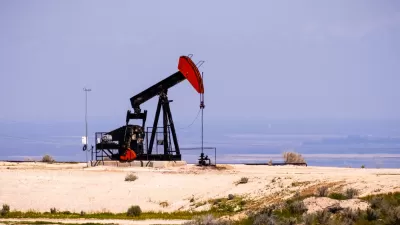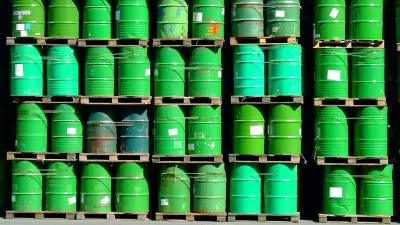Gas prices are on the rise, though they will remain well below 2014 levels through this year. U.S. oil production dropped by 600,000 barrels from last year, while gas consumption is on track to break the 2007 record thanks to cheap gas and more SUVs.
"On Thursday (March 24), the national average for a gallon of regular gasoline rose above $2 a gallon for the first time since Dec. 31...," writes Clifford Krauss, energy correspondent for The New York Times on March 25. "The principal reason for the rise in gasoline prices is the roughly 50 percent spike in the American oil benchmark from $26 a barrel on Feb. 11 to just over $40 a barrel...."
Krauss lists other reasons for the recent increase as well, including:
- Refinery problems in Southern California resulting in "Californians paying an average of $2.73 a gallon for regular gas, according to AAA, 72 cents higher than the national average and 42 cents more than they were paying a month ago."
- "[C]hanges in seasonal driving habits, including spring break road trips. At the same time, many refineries are retooling to produce summer blends, which leads to a temporary decline in local fuel production."
More importantly, the price decrease, which began in July, 2014, and accelerated after OPEC chose not to decrease production that November, has resulted in fundamental economic changes. As one would expect, oil production is down and fuel consumption is up, particularly in the United States, where the economy is relatively sound.
Government weekly estimates of domestic gasoline demand so far this year suggest a 4 percent increase over the same period last year, leading some to project that the country should easily surpass its 2007* record for gasoline consumption.
The gas increase stems in part from changes in the U.S. fleet composition as consumers are buying more SUVs and fewer fuel efficient vehicles. "Fuel economy is down 0.6 mpg from the peak reached in August 2014, but still up 5.1 mpg since October 2007," writes Dr. Michael Sivak, transportation researcher for University of Michigan Transportation Research Institute (UMTRI), in an email on March 3. UMTRI conducts monthly monitoring of vehicle fuel economy and emissions.
(click on the graph to view full size)
The automotive industry may use that shift in buyer preferences to relax President Obama's mileage goal of 54.5 MPG by 2025, writes Times correspondent Bill Vlasic on March 22.
Turning to the supply side of the law of supply and demand, OPEC's strategy of retaining market share by not lowering prices to stabilize the market, as they usually have done, is working.
"The oil and gas industry continues to suffer through its worst downturn in more than a generation," writes Krauss.
At $40 a barrel, most oil companies can avert bankruptcy, but few wells can be profitably drilled, and financial turmoil still grips the industry.
That has caused a sharp drop in American production, by about 600,000 barrels a day from a year ago.
More on the slump in U.S. oil production, particularly on the mounting debt of smaller producers, can be read in this Washington Post Wonkblog piece by Chico Harlan
On an international scale, "[t]here is also the possibility that Saudi Arabia, Russia and a handful of other producers will freeze their output in the coming weeks," adds Krauss.
Several of the largest international producers will gather in Doha [Qatar] next month to discuss curtailing or at least restraining output. Nevertheless most experts expect that the current, stubborn worldwide glut in oil and petroleum products should keep crude prices well below their average levels of the last decade until at least the end of the year.
As for the injection of Iranian oil into the world market due to the lifting of nuclear sanctions, "that modest addition has been more than offset by terrorist attacks on pipelines in the Middle East and unplanned production outages in several countries," notes Krauss.
FULL STORY: Gas Prices Will Be Low for Easter, but Don’t Get Used to It

Depopulation Patterns Get Weird
A recent ranking of “declining” cities heavily features some of the most expensive cities in the country — including New York City and a half-dozen in the San Francisco Bay Area.

California Exodus: Population Drops Below 39 Million
Never mind the 40 million that demographers predicted the Golden State would reach by 2018. The state's population dipped below 39 million to 38.965 million last July, according to Census data released in March, the lowest since 2015.

Chicago to Turn High-Rise Offices into Housing
Four commercial buildings in the Chicago Loop have been approved for redevelopment into housing in a bid to revitalize the city’s downtown post-pandemic.

EV Infrastructure Booming in Suburbs, Cities Lag Behind
A lack of access to charging infrastructure is holding back EV adoption in many US cities.

Seattle Road Safety Advocates Say Transportation Levy Perpetuates Car-Centric Status Quo
Critics of a proposed $1.3 billion transportation levy say the package isn’t enough to keep up with inflation and rising costs and fails to support a shift away from car-oriented infrastructure.

Appeals Court: California Emissions Standards Upheld
The U.S. Environmental Protection Agency and the California Air Resources Board, the nation's two most powerful environmental regulatory agencies, won an important round in federal court last week. But the emissions standards battle may not be over.
Barrett Planning Group LLC
City of Cleburne
KTUA Planning and Landscape Architecture
HUD's Office of Policy Development and Research
Mpact Transit + Community
HUD's Office of Policy Development and Research
City of Universal City TX
ULI Northwest Arkansas
City of Laramie, Wyoming
Urban Design for Planners 1: Software Tools
This six-course series explores essential urban design concepts using open source software and equips planners with the tools they need to participate fully in the urban design process.
Planning for Universal Design
Learn the tools for implementing Universal Design in planning regulations.























